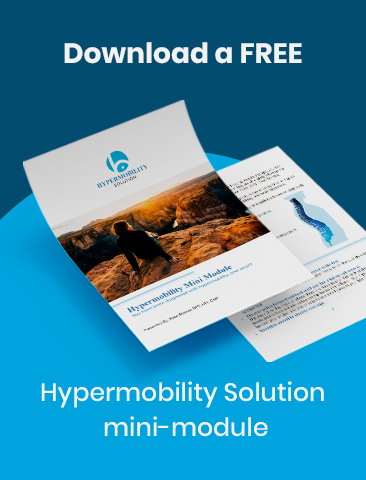Read this article to learn the 3 tactics for explaining hypermobility to others, such as:
- Family: keep things broad and simple.
- Friends: only provide the information that you feel comfortable giving.
- Colleagues: keep it short, sweet, and to the point.
Explaining hypermobility to friends and family
Keep things broad and straightforward. Often, our hypermobility can be overwhelming to explain due to its complex nature.
When explaining your complex condition to friends and family, you will want to get a read on their understanding of your diagnosis and symptoms to determine the level of detail you wish to provide surrounding your condition.
If your friend or family member is not incredibly familiar with hypermobility, or related complex conditions, sometimes keeping the conversation around the topic broader can be better.
If this is the approach you decide to take, you can start the conversation by mentioning that you have pain, an issue with, or simply a problem, and you’re working on managing your symptoms.
Often, this is more than enough for most. And, with this information, your friends and family will more than likely want to support you.
If you can provide them with suggestions or ways that they can help you (and it doesn’t have to be just physically), they will more than likely be very willing to help.
Before you have this broad conversation with a friend or family member, you may want to think to yourself about how the individual you’re explaining your condition can help you.
That way, you’re prepared, and they can feel they are lending a helping hand.

Explaining hypermobility to colleagues
Explaining your complex condition to coworkers can be a bit more tricky than explaining to family or friends, but it does not have to be complicated.
Because your coworkers will engage with you in different conversations and tasks than people such as your family and friends, your discussion may look different in a few ways.
When explaining your condition or syndrome to your coworkers, keep it short, sweet, and to the point. Your coworkers don’t need to know every detail. They need to be aware of the situation so that they can be of help to you.
One of my favorite things to do before I know this type of conversation will take place is to create “catchphrases.”
These are phrases that I use to explain my condition or what I am (or am not) capable of doing due to my hypermobility in a work environment.
For instance, you can say something along the lines of:
You can also blame your hypermobility on a joint injury by using a catchphrase along the lines of:
Then, follow up that statement in a way that your coworker can help. For example:
You don’t have to explain your entire situation. But, informing others that you may need a little extra help with a few things will help them better understand.
This way, they can help you without having a long and personal conversation about your condition.
If you figure out these phrases, you’ll be setting yourself up for a helpful and constructive explanation of your condition with the transparency needed to get help without oversharing.
Help the people in your life help you
By taking the time to explain hypermobility, you’re raising awareness and advocating for yourself and others.
You should never feel obligated to thoroughly explain your condition (unless you want to do so of your own volition).
But, by bringing up your condition, you’re allowing others to understand your situation, along with others who have hypermobility.
When you do so, you’re raising awareness, helping make your life more accessible, and helping others’ lives.
If you are looking for Hypermobility resources, feel free to check out my blog.
Are you looking to manage your Hypermobility symptoms?
Check out the Hypermobility Solution, the Hypermobile Neck Solution, and Hypermobility 101.

About Kate

Kate Skinner is a Doctor in Physical Therapy, co-founder of Great Divide Physical Therapy, and creator of Hypermobility Solution.
Recent Posts


